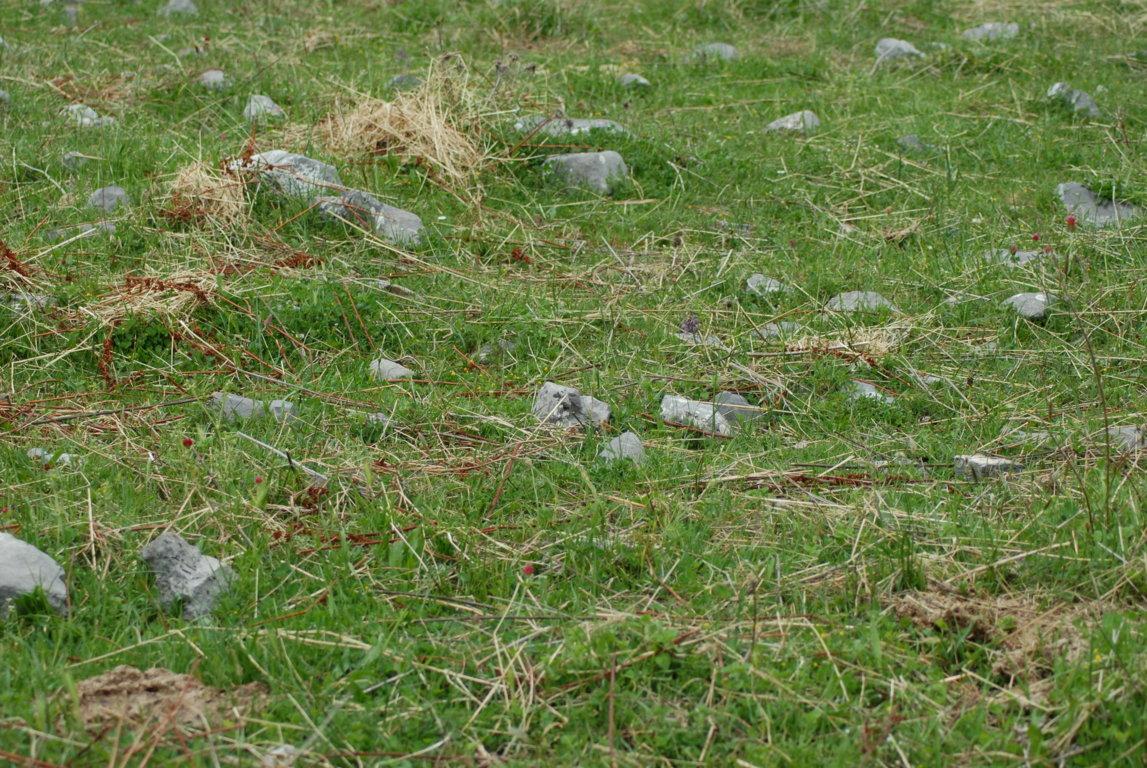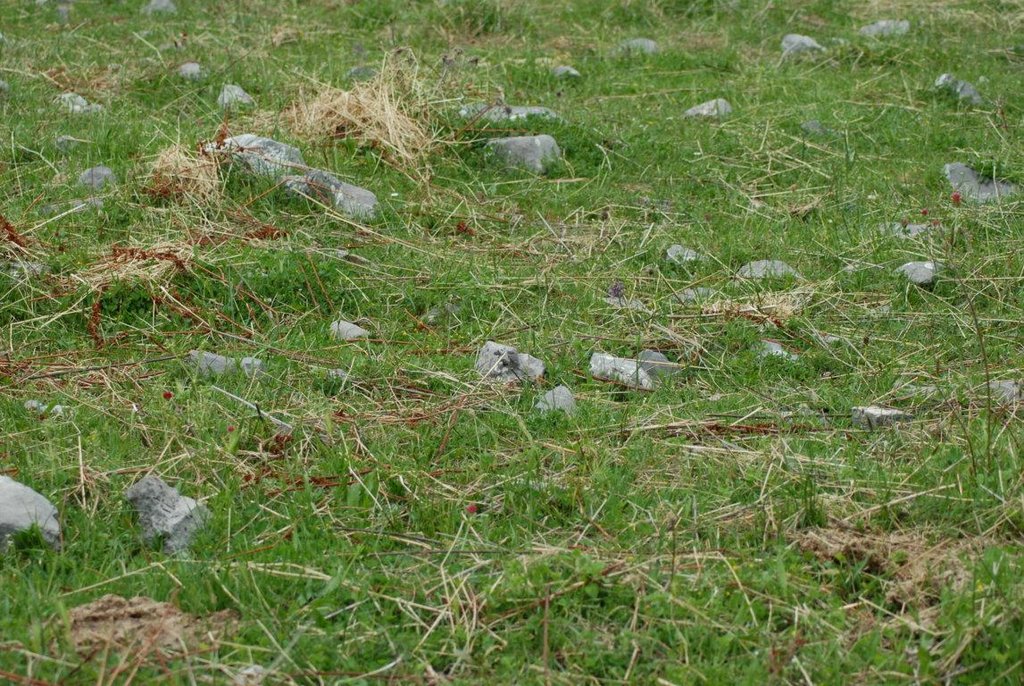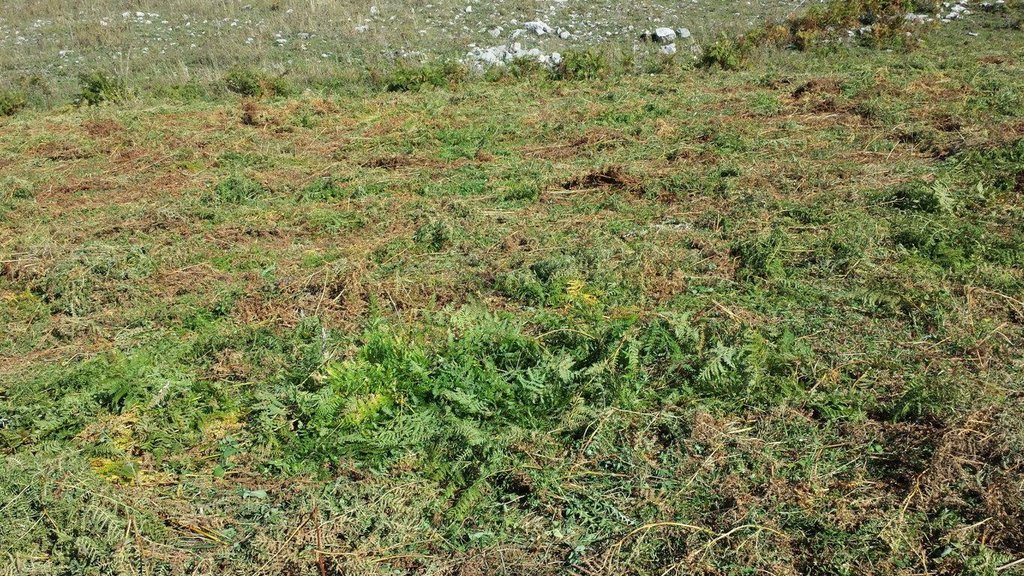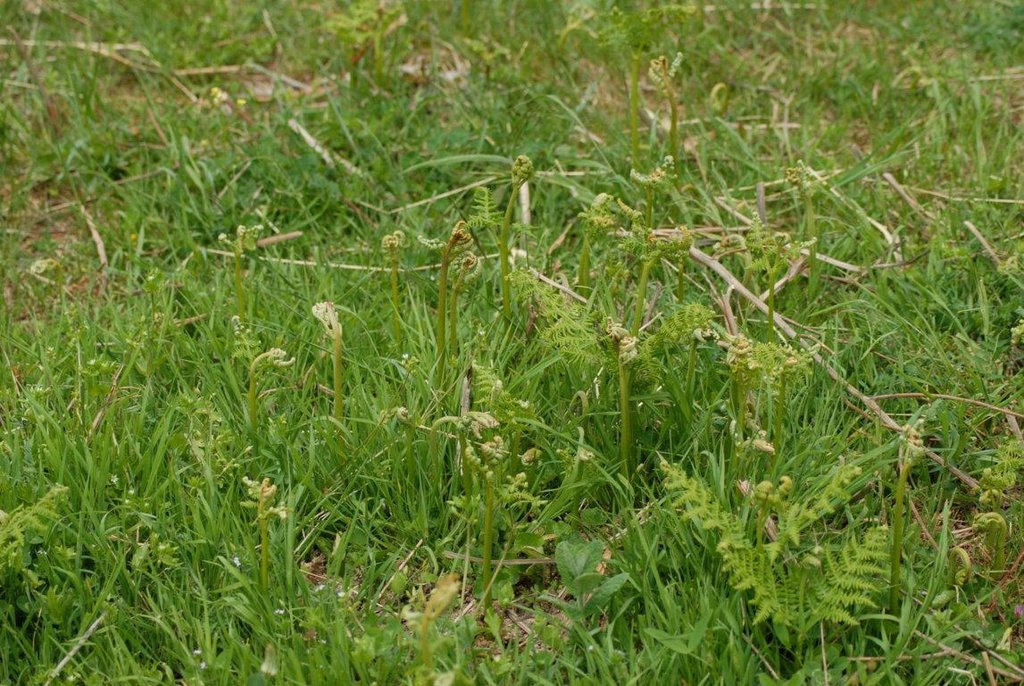Cutting of Ferns in degraded pastures to use as litter and fodder [Italy]
- Creation:
- Update:
- Compiler: Velia De Paola
- Editor: –
- Reviewer: Fabian Ottiger
technologies_1214 - Italy
View sections
Expand all Collapse all1. General information
1.2 Contact details of resource persons and institutions involved in the assessment and documentation of the Technology
SLM specialist:
Quaranta Giovanni
University of Basilicata
Via Nazario Sauro, 85, 85100 Potenza, Ita
Italy
Name of project which facilitated the documentation/ evaluation of the Technology (if relevant)
Catastrophic shifts in drylands (EU-CASCADE)Name of the institution(s) which facilitated the documentation/ evaluation of the Technology (if relevant)
University of Basilicata - Italy1.3 Conditions regarding the use of data documented through WOCAT
When were the data compiled (in the field)?
26/05/2014
The compiler and key resource person(s) accept the conditions regarding the use of data documented through WOCAT:
Yes
2. Description of the SLM Technology
2.1 Short description of the Technology
Definition of the Technology:
Cutting of wild ferns for fodder production and to mitigate pasture degradation.
2.2 Detailed description of the Technology
Description:
Ferns are considered pioneer plants because Wherever there is fertile, acidic and well drained land Ferns (Pteridium sp.) preceed shrub species and the encroaching of forest species. Ferns that develop on pastures are fairly un-palatable to grazing livestock and completely disregarded by animals when the plant is fresh. The plant is thus usually mowed down to clear pastures and make way for more palatable species which would otherwise be suffocated by the presence of ferns. However, once cut down, dried and gathered, ferns can be used during the winter months (when the animals are in sheds or stables), both as a source of fibre and as bedding in deep litter housing systems (in place of the more common use of straw).
Purpose of the Technology: Improve pasture quality and gathering of fodder/ litter
Establishment / maintenance activities and inputs: End of summer/beginning of fall farmers use to cut ferns in the fields where they are diffused. Usually they use tractor whit a cutting equipment. As they get dry (it takes from 3 to 6 days according to air temperature and humidity) the ferns are collected and stored for winter use, either as fodder or litter housing.
Natural / human environment: The context of production is characterised by a medium level of mechanisation (only the most demanding operations are carried out using mechanical means), the production system is essentially mixed, a small part is destined for personal consumption whilst the bulk of production is destined for local markets. The property is predominantly
privately owned but also includes some public land, especially in the case of pasture land. Most farms in the area are livestock farms whilst the agricultural component is destined exclusively for private consumption. The technique is mainly applied on higher latitude pasture land (because of the presence of acidic soils) which are not particularly stony.
2.3 Photos of the Technology
2.5 Country/ region/ locations where the Technology has been applied and which are covered by this assessment
Country:
Italy
Region/ State/ Province:
Basilicata
Further specification of location:
castelsaraceno
2.6 Date of implementation
If precise year is not known, indicate approximate date:
- more than 50 years ago (traditional)
2.7 Introduction of the Technology
Specify how the Technology was introduced:
- as part of a traditional system (> 50 years)
3. Classification of the SLM Technology
3.2 Current land use type(s) where the Technology is applied

Grazing land
Extensive grazing land:
- Semi-nomadism/ pastoralism
- Ranching
Main animal species and products:
Main animal species ranching: Sheep/Goats/Cow
Comments:
Major land use problems (compiler’s opinion): Pasture degradation (shrub encroachment)
Major land use problems (land users’ perception): Pasture degradation (shrub encroachment)
Semi-nomadism / pastoralism: Shepherds use the area for summer grazing and move downhill in winter
Grazingland comments: the technique is applied in livestock farms which raise both cattle and sheep and goats seeing as
fresh ferns are un-palatable to all grazing species.
Type of grazing system comments: the technique is applied in livestock farms which raise both cattle and sheep and goats seeing as
fresh ferns are un-palatable to all grazing species.
3.3 Further information about land use
Water supply for the land on which the Technology is applied:
- rainfed
Comments:
Water supply: Also mixed rainfed - irrigated
Number of growing seasons per year:
- 1
Specify:
Longest growing period in days: 120Longest growing period from month to month: March to august
Livestock density (if relevant):
> 100 LU /km2
3.4 SLM group to which the Technology belongs
- pastoralism and grazing land management
- fodder production and mitigation pasture degradation
3.5 Spread of the Technology
Specify the spread of the Technology:
- evenly spread over an area
If the Technology is evenly spread over an area, indicate approximate area covered:
- 0.1-1 km2
3.6 SLM measures comprising the Technology

vegetative measures
- V2: Grasses and perennial herbaceous plants

management measures
- M5: Control/ change of species composition
Comments:
Main measures: management measures
Secondary measures: vegetative measures
Type of vegetative measures: scattered / dispersed
3.7 Main types of land degradation addressed by the Technology

biological degradation
- Bs: quality and species composition/ diversity decline
Comments:
Main type of degradation addressed: Bs: quality and species composition /diversity decline
Secondary causes of degradation: other human induced causes (specify) (Undergrazing, decrease in land use and land management)
3.8 Prevention, reduction, or restoration of land degradation
Specify the goal of the Technology with regard to land degradation:
- restore/ rehabilitate severely degraded land
Comments:
Secondary goals: rehabilitation / reclamation of denuded land
4. Technical specifications, implementation activities, inputs, and costs
4.2 Technical specifications/ explanations of technical drawing
Technical knowledge required for land users: low
Main technical functions: promotion of vegetation species and varieties (quality, eg palatable fodder)
Scattered / dispersed
Vegetative material: G : grass
Number of plants per (ha): 150000
Control / change of species composition
4.3 General information regarding the calculation of inputs and costs
other/ national currency (specify):
euro
Indicate exchange rate from USD to local currency (if relevant): 1 USD =:
0.74
Indicate average wage cost of hired labour per day:
81.08
4.6 Maintenance/ recurrent activities
| Activity | Type of measure | Timing/ frequency | |
|---|---|---|---|
| 1. | Cutting and gathering of fern | Vegetative | Once a year |
| 2. | Cutting and gathering of ferns | Management | Once a year |
4.7 Costs and inputs needed for maintenance/ recurrent activities (per year)
| Specify input | Unit | Quantity | Costs per Unit | Total costs per input | % of costs borne by land users | |
|---|---|---|---|---|---|---|
| Labour | Cutting and gathering of fern | ha | 1.0 | 162.16 | 162.16 | 100.0 |
| Equipment | Cutting and gathering of fern | ha | 1.0 | 108.1 | 108.1 | 100.0 |
| Total costs for maintenance of the Technology | 270.26 | |||||
Comments:
Machinery/ tools: Tractor with mower which is commonly owned for medium to large livestock farms for the purpose of haying., tractor with mower which is commonly owned for medium to large livestock farms for the purpose of haying.
4.8 Most important factors affecting the costs
Describe the most determinate factors affecting the costs:
The technique does not require specific investment given that the necessary equipment is usually already available on farm in the case of medium to large size livestock farms. The work is carried out in autumn when the machinery are not generally in use as haying operations are usually finished in the summer months.
If the farm does not own suitable machinery it can be rented at a cost of €40 per hour.
5. Natural and human environment
5.1 Climate
Annual rainfall
- < 250 mm
- 251-500 mm
- 501-750 mm
- 751-1,000 mm
- 1,001-1,500 mm
- 1,501-2,000 mm
- 2,001-3,000 mm
- 3,001-4,000 mm
- > 4,000 mm
Specify average annual rainfall (if known), in mm:
1519.00
Specifications/ comments on rainfall:
68% in winter and 15% in summer
Agro-climatic zone
- sub-humid
Thermal climate class: temperate
5.2 Topography
Slopes on average:
- flat (0-2%)
- gentle (3-5%)
- moderate (6-10%)
- rolling (11-15%)
- hilly (16-30%)
- steep (31-60%)
- very steep (>60%)
Landforms:
- plateau/plains
- ridges
- mountain slopes
- hill slopes
- footslopes
- valley floors
Altitudinal zone:
- 0-100 m a.s.l.
- 101-500 m a.s.l.
- 501-1,000 m a.s.l.
- 1,001-1,500 m a.s.l.
- 1,501-2,000 m a.s.l.
- 2,001-2,500 m a.s.l.
- 2,501-3,000 m a.s.l.
- 3,001-4,000 m a.s.l.
- > 4,000 m a.s.l.
5.3 Soils
Soil depth on average:
- very shallow (0-20 cm)
- shallow (21-50 cm)
- moderately deep (51-80 cm)
- deep (81-120 cm)
- very deep (> 120 cm)
Soil texture (topsoil):
- fine/ heavy (clay)
Topsoil organic matter:
- medium (1-3%)
If available, attach full soil description or specify the available information, e.g. soil type, soil PH/ acidity, Cation Exchange Capacity, nitrogen, salinity etc.
Soil fertility is medium-low
Soil drainage/infiltration is good
Soil water storage capacity is medium
5.4 Water availability and quality
Ground water table:
5-50 m
Availability of surface water:
medium
Water quality (untreated):
good drinking water
Comments and further specifications on water quality and quantity:
Availability of surface water is medium (minimum during month of September and October)
5.5 Biodiversity
Species diversity:
- medium
5.6 Characteristics of land users applying the Technology
Market orientation of production system:
- commercial/ market
Off-farm income:
- 10-50% of all income
Relative level of wealth:
- average
Individuals or groups:
- individual/ household
Gender:
- women
Indicate other relevant characteristics of the land users:
Land users applying the Technology are mainly common / average land users
Difference in the involvement of women and men: Active farmers are present only males; women are not actively involved in land management
Population density: 10-50 persons/km2
Annual population growth: negative; 2%
90% of the land users are average wealthy.
10% of the land users are poor.
Off-farm income specification: Most of the off farm income derives from public sector, i.e. Municipality, Mountain Community, Region and other public bodies. Very few farmer members run local shops or handcraft.
5.7 Average area of land owned or leased by land users applying the Technology
- < 0.5 ha
- 0.5-1 ha
- 1-2 ha
- 2-5 ha
- 5-15 ha
- 15-50 ha
- 50-100 ha
- 100-500 ha
- 500-1,000 ha
- 1,000-10,000 ha
- > 10,000 ha
Is this considered small-, medium- or large-scale (referring to local context)?
- small-scale
Comments:
Considering communal land used by farmers
5.8 Land ownership, land use rights, and water use rights
Land ownership:
- communal/ village
- individual, titled
Land use rights:
- communal (organized)
- individual
5.9 Access to services and infrastructure
health:
- poor
- moderate
- good
education:
- poor
- moderate
- good
technical assistance:
- poor
- moderate
- good
employment (e.g. off-farm):
- poor
- moderate
- good
markets:
- poor
- moderate
- good
energy:
- poor
- moderate
- good
roads and transport:
- poor
- moderate
- good
drinking water and sanitation:
- poor
- moderate
- good
financial services:
- poor
- moderate
- good
6. Impacts and concluding statements
6.1 On-site impacts the Technology has shown
Socio-economic impacts
Production
crop production
fodder production
fodder quality
production area
Socio-cultural impacts
Improved livelihoods and human well-being
Ecological impacts
Biodiversity: vegetation, animals
habitat diversity
6.2 Off-site impacts the Technology has shown
damage on neighbours' fields
6.3 Exposure and sensitivity of the Technology to gradual climate change and climate-related extremes/ disasters (as perceived by land users)
Gradual climate change
Gradual climate change
| Season | Type of climatic change/ extreme | How does the Technology cope with it? | |
|---|---|---|---|
| annual temperature | increase | well |
Climate-related extremes (disasters)
Meteorological disasters
| How does the Technology cope with it? | |
|---|---|
| local rainstorm | well |
| local windstorm | well |
Climatological disasters
| How does the Technology cope with it? | |
|---|---|
| drought | well |
Hydrological disasters
| How does the Technology cope with it? | |
|---|---|
| general (river) flood | well |
Other climate-related consequences
Other climate-related consequences
| How does the Technology cope with it? | |
|---|---|
| reduced growing period | well |
Comments:
In order to make ferns dry up in such environment it would be possible to cut them during last stage of summer rather then early autumn to avoid possible persistent rain that would not allow ferns to dry up.
6.4 Cost-benefit analysis
How do the benefits compare with the establishment costs (from land users’ perspective)?
Short-term returns:
slightly negative
Long-term returns:
very positive
How do the benefits compare with the maintenance/ recurrent costs (from land users' perspective)?
Short-term returns:
very positive
Long-term returns:
very positive
Comments:
In the short term the advantage is an increase in surface and quality of valuable pastures. for the grazing animals. In the long term the application of this technique is important to prevent shrub encroachment.
6.5 Adoption of the Technology
Of all those who have adopted the Technology, how many have did so spontaneously, i.e. without receiving any material incentives/ payments?
- 90-100%
Comments:
100% of land user families have adopted the Technology without any external material support
There is a moderate trend towards spontaneous adoption of the Technology
6.7 Strengths/ advantages/ opportunities of the Technology
| Strengths/ advantages/ opportunities in the land user’s view |
|---|
| ferns are used in winter as fodder which absorbs the cost of cutting and gathering ferns from pastures and also helps improve pasture quality. |
| Strengths/ advantages/ opportunities in the compiler’s or other key resource person’s view |
|---|
|
the cutting of ferns is a simple, low-cost operation which brings great benefits to livestock farms. How can they be sustained / enhanced? Greater exchange of information amongst target farmers on the benefits of clearing pastures. |
Links and modules
Expand all Collapse allLinks
No links
Modules
No modules





